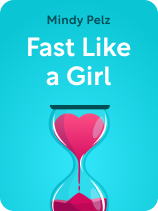

This article is an excerpt from the Shortform book guide to "Fast Like a Girl" by Mindy Pelz. Shortform has the world's best summaries and analyses of books you should be reading.
Like this article? Sign up for a free trial here.
How long should an intermittent fasting length be? How does fasting create hormetic stress?
Mindy Pelz says there are six intermittent fasting lengths you can try to get the full benefits. Choosing one depends on what your body can handle, and what type of results you’re looking for.
Let’s look at how to incorporate different fasting lengths into your routine.
How to Incorporate Different-Length Fasts Into Your Routine
According to Pelz, incorporating different intermittent fasting lengths into your routine prevents your body from adapting to the fasting state, ensuring continued long-term benefits. To clarify how this works, we’ll explore how your cells respond to both glucose and ketones, then explain how strategically switching between these two fuel sources (by varying fasting lengths) guarantees ongoing benefits.
There are downsides to relying solely on glucose as an energy source. However, this doesn’t mean you should always prevent your body from burning glucose. Both fuel sources are essential for your body to function optimally.
- When your body burns glucose, it activates mTOR signaling, a process that builds new cellular structures and contributes to hormone production, muscle building, and cell regeneration.
- When your body burns ketones, it activates autophagy, the cellular detox process we discussed above that breaks down and removes damaged components.
(Shortform note: Research expands on why your body needs both fuel sources. Glucose is the primary source of energy for all cells. However, relying solely on glucose for energy can cause hyperglycemia, which damages nerves, blood vessels, and organs. Further, glucose provides less cellular energy than ketones: Metabolizing 100 g of glucose generates 8.7 kg of energy-carrying molecules. Metabolizing 100 g of ketones generates between 9.4 and 10.5 kg of energy-carrying molecules. While ketones provide more cellular energy, relying solely on them for energy would result in no glucose in the bloodstream, which would affect the central nervous system and cause cellular dysfunction or death.)
Pelz explains that switching between these two states (by eating and fasting) creates hormetic stress, a beneficial form of stress that encourages cellular adaptation and resilience—like the way new exercises challenge muscles. However, sticking to the same fasting routine every day reduces this stress, causing you to miss out on the beneficial effects of switching between fuel sources. This is because your body gets too comfortable with routine—just as doing the same exercises every day stops having an effect. Therefore, Pelz argues that incorporating different-length fasts prevents your body from adapting to a specific fasting pattern, ensuring it benefits from fasting over the long term.
(Shortform note: While fasting experts such as Dave Asprey (Fast This Way) and Gin Stephens (Fast. Feast. Repeat.) agree that switching between different fasting durations helps overcome plateaus, other experts argue that sticking to consistent eating times is better for your health. They explain that eating at regular times helps you maintain a healthy circadian rhythm (the body’s internal 24-hour clock) and that irregular eating can lead to obesity, high blood pressure, and type 2 diabetes.)
Six Fasting Lengths and Their Specific Health Advantages
In addition to encouraging healthy hormetic stress, practicing diverse fasting durations provides a spectrum of health advantages. Pelz explains that, generally, your body shifts to burning ketones after eight hours of fasting, and the specific health benefits vary based on the duration of the fast.
- 12 to 16 hours: aids in weight loss, enhances mental clarity, and boosts energy levels
- At least 17 hours: detoxes cells, improves memory and cognition, increases resilience against viruses, and balances female sex hormones
- At least 24 hours: creates stem cells that repair gut lining damage caused by unhealthy bacteria, antibiotics, or birth control
- At least 36 hours: reduces cholesterol and maximizes weight loss by converting excess glucose into ketones
- At least 48 hours: calms anxiety and resets dopamine levels, making it easier to experience joy
- At least 72 hours: maximizes the production of stem cells that rejuvenate the immune system, heal injuries, and reverse the effects of chronic illnesses or age-related decline
Opinions Differ on the Health Benefits of Different Fasting Durations
While Pelz ties different fasting lengths to specific health advantages, it’s important to note that various factors, such as physiology, lifestyle, and health conditions can influence the way these benefits unfold. In essence, a fasting duration that creates advantages for one person might not yield the same results for another.
Further, opinions vary on how different fasting lengths impact your health. For example, some experts suggest the following timeline:
- 4 to 16 hours: depletes glucose reserves, transitions the body into ketosis, and activates autophagy
- 16 to 24 hours: burns fat, detoxes cells, and increases growth hormone levels
- 24 to 72 hours: increases the rate at which the body burns fat and enhances mental clarity
- 72 hours +: triggers stem cell production and supports the creation of new neural networks
Meanwhile, other experts propose a different timeline:
- 8 to 12 hours: triggers glycogen metabolism, stabilizes blood sugar levels, and transitions the body into the early stages of ketosis—effects that can help lower blood pressure and increase insulin sensitivity
- 12 to 18 hours: enters full ketosis, burns body fat, suppresses appetite, and boosts BDNF levels to enhance mental clarity
- 24 hours: triggers autophagy, which detoxes cells and reduces inflammation
- 36 to 48 hours: increases growth hormone production, which promotes muscle growth and repair
- 72 hours +: triggers stem cell production, which helps rejuvenate the immune system
These differing opinions suggest that the link between specific fasting durations and health advantages may not be as clear-cut as Pelz suggests.

———End of Preview———
Like what you just read? Read the rest of the world's best book summary and analysis of Mindy Pelz's "Fast Like a Girl" at Shortform.
Here's what you'll find in our full Fast Like a Girl summary:
- Why women should be aligning their fasting schedules with their hormonal cycles
- Tips for prolonging and enhancing the benefits of fasting
- How mistiming your fasting can deprive your hormones of nourishment






